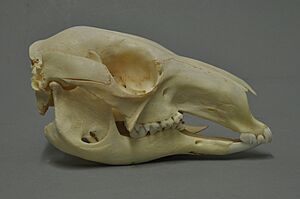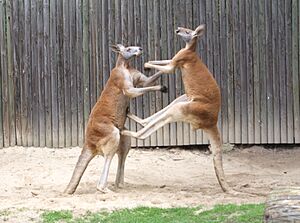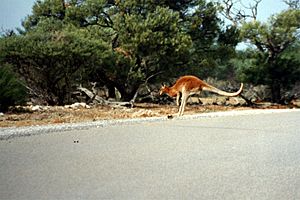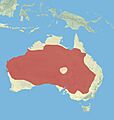Red kangaroo facts for kids
Quick facts for kids Red kangaroo |
|
|---|---|
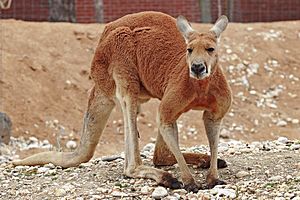 |
|
| A male at Healesville Sanctuary in Healesville, Victoria | |
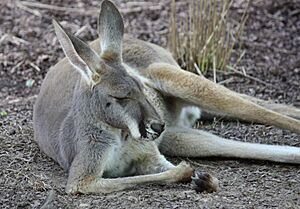 |
|
| A female at the Nashville Zoo in Nashville, Tennessee | |
| Conservation status | |
 Delisted (ESA) |
|
| Scientific classification | |
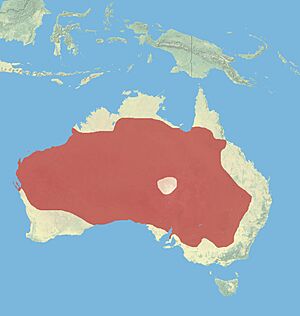 |
|
| Synonyms | |
|
List
Kangurus rufus Desmarest, 1822
Kangurus laniger Gaimard, 1823 Kangurus griseolanosus Quoy & Gaimard, 1825 Macropus lanigerus Gray, 1825 Kangurus lanosus Gray, 1827 Kangurus lanosus Gray, 1843 Macropus (Osphranter) pictus Gould, 1861 Macropus ruber Crisp, 1862 Macropus (Boriogale) magnus Owen, 1874 Macropus rufus dissimulatus Rothschild, 1905 Macropus rufus occidentalis Cahn, 1906 Macropus rufus dissimulator Lydekker, 1906 Macropus rufus pallidus Schwarz, 1910 |
The red kangaroo (Osphranter rufus) is the biggest of all kangaroos. It is also the largest land mammal that lives in Australia. In fact, it is the largest living marsupial in the world. You can find red kangaroos almost everywhere in mainland Australia. They do not live in very fertile areas, like southern Western Australia. They also avoid the eastern and southeastern coasts, and the rainforests up north.
Contents
Understanding Red Kangaroo Classification
The red kangaroo was first described in 1822 by a scientist named A.G. Desmarest. He first put it in a group called Kangurus. Later, in 1842, another scientist named Gould moved it to the genus Osphranter. For a long time, Osphranter was considered a smaller group within Macropus.
However, in 2015, scientists decided to change this. They moved Osphranter back to being its own main group, or genus. This means the red kangaroo is now officially part of the Osphranter genus. Genetic studies in 2019 supported this change.
What Does a Red Kangaroo Look Like?

Red kangaroos are very large animals. They have long, pointed ears and a square-shaped snout. Male kangaroos have short, reddish-brown fur. This fur fades to a pale color on their bellies and legs.
Female kangaroos are smaller than males. They usually have blue-grey fur with a brownish tint. Their undersides are pale grey. However, females living in very dry areas might look more like the males.
Red kangaroos have two front limbs with small claws. Their two strong hind legs are used for jumping. They also have a powerful tail. This tail helps them balance and can even act like a third leg when they stand up tall.
Size and Weight of Red Kangaroos
Male red kangaroos are often called "Big Reds" in Australia. They can grow to be about 1.3 to 1.6 meters (4.3 to 5.2 feet) long from head to body. Their tail can add another 1.2 meters (3.9 feet) to their total length.
Females are much smaller. Their head and body length is usually between 85 and 105 centimeters (2.8 to 3.4 feet). Their tails are about 65 to 85 centimeters (2.1 to 2.8 feet) long. Females can weigh from 18 to 40 kilograms (40 to 88 pounds). Males are much heavier, typically weighing 55 to 90 kilograms (121 to 198 pounds).
An average red kangaroo stands about 1.5 meters (4.9 feet) tall when upright. Very large males can stand over 1.8 meters (5.9 feet) tall. The tallest one ever recorded was about 2.1 meters (6.9 feet) tall and weighed 91 kilograms (201 pounds).
How Red Kangaroos Stay Cool
Red kangaroos are amazing at keeping their body temperature steady, around 36°C (97°F). They have special ways to do this, especially in hot weather.
- They have a thick layer of fur that helps keep them warm in cold weather and cool in hot weather.
- When it's hot, they are less active and stay in the shade.
- They can pant and sweat to cool down.
- They also lick their forelimbs. As the saliva evaporates, it helps cool their blood.
Red kangaroos can survive for a long time without drinking water. They get most of the moisture they need from the plants they eat. Their kidneys are also very good at saving water by making their urine very concentrated. In very tough conditions, they can even enter a state of torpor. This is like a mini-hibernation that helps them save energy.
Red Kangaroo Vision
Red kangaroos have a wide range of vision, about 300 degrees. This is because their eyes are placed on the sides of their heads. This wide view helps them spot predators from many directions.
How Red Kangaroos Move
The legs of a red kangaroo work a bit like a rubber band. When the kangaroo lands, its Achilles tendon stretches. Then, this stored energy is released, pushing the kangaroo up and forward. This is how they get their famous bouncing movement.
Red kangaroos can hop very fast, reaching speeds of about 60 kilometers per hour (37 miles per hour). Males can cover 8 to 9 meters (26 to 30 feet) in a single leap. They can also jump quite high, from 1.8 to 3 meters (5.9 to 9.8 feet), though usually it's around 1.2 to 1.9 meters (3.9 to 6.2 feet).
Where Red Kangaroos Live and What They Eat

Red kangaroos live across western and central Australia. Their homes include scrublands, grasslands, and deserts. They prefer open areas that have some trees for shade. These kangaroos are very good at living in dry places. They can find enough water and fresh plants to survive even when it's very dry. Their kidneys are excellent at saving water, especially in summer.
Red kangaroos mostly eat green plants, especially fresh grasses and forbs (small flowering plants). They can find enough food even when most plants look brown and dry. One study found that green grass makes up 75–95% of their diet. They particularly like a grass called Eragrostis setifolia. During dry times, they look for green plants in open grasslands and near water. If their favorite foods are scarce, they might eat other plants like certain types of chenopods or even shrubs.
Daily Life and Travel
Sometimes, many red kangaroos gather together. In places with lots of food, these groups can have as many as 1,500 kangaroos! Red kangaroos are usually active around dawn and dusk, and at night. They rest in the shade during the hottest parts of the day. However, they sometimes move around during the day too. They often use small saltbushes or mulga bushes for shelter from extreme heat.
Grazing, or eating grass, takes up most of their day. Like most kangaroos, they usually stay in a specific home area. But if the environment changes a lot, like during a drought, they might travel long distances to find food. Kangaroos in New South Wales have weekly home ranges of 258–560 hectares (637–1,384 acres). Adult males tend to have larger areas. If food is scarce, they might travel 25–30 kilometers (15–19 miles) to better feeding grounds.
Predators and Defense
Adult red kangaroos are so big that not many animals hunt them. However, dingoes and large birds of prey can hunt baby kangaroos, called joeys. Sometimes, a group of dingoes or a pair of wedge-tailed eagles might even hunt adult kangaroos. Saltwater crocodiles can also prey on kangaroos.
Kangaroos are good swimmers. If they feel threatened by a predator on land, they will often jump into water. If a predator follows them into the water, a kangaroo might use its strong front paws to hold the predator underwater.
Red Kangaroo Behaviour

Red kangaroos usually live in small groups of 2 to 4 members. The most common groups are females with their young. Larger groups can be found where there are many kangaroos. Females are usually found with a male. The members of these groups can change easily.
Male kangaroos, called "boomers," do not defend a specific territory. They only fight over females, called "flyers," when they are ready to mate. Males grow much larger shoulders and arms than females. Most fights happen between young males. These fights are like a ritual, often called boxing.
Kangaroo Boxing
When kangaroos box, they stand on their hind legs. They try to push their opponent off balance by jabbing them or locking forearms. If the fight gets more serious, they will start to kick each other. They use their strong tail to support their weight while delivering powerful kicks with their hind legs. Compared to other kangaroo species, red kangaroo males tend to wrestle more during fights. These fights help establish which male is stronger and more dominant. Males who lose these fights often live alone and avoid other kangaroos.
Red Kangaroo Reproduction and Life Cycle
Red kangaroos can breed all year round. Female kangaroos have an amazing ability called embryonic diapause. This means they can delay the birth of their new baby until their older joey has left the pouch. This is very helpful during dry times or when food is scarce.
Usually, only one joey is born at a time. When born, the joey is tiny, blind, and has no fur. Its hind legs are just small stumps. It uses its more developed front legs to climb through its mother's fur into the pouch. This climb takes about three to five minutes.
The baby joey grows quickly inside the pouch. After about 190 days (around 6 months), the joey is big enough to start poking its head out of the pouch. After a few weeks of doing this, it feels safe enough to fully come out. From then on, it spends more and more time outside the pouch. Finally, after about 235 days (around 8 months), it leaves the pouch for good. Even after leaving the pouch, the young joey will continue to drink its mother's milk until it is about 12 months old.
A female kangaroo can start having babies as early as 18 months old. But usually, she is about two and a half years old before she starts breeding. During droughts, she might wait until she is five years old.
Amazing Mother Kangaroos
A female red kangaroo is usually pregnant all the time, except for the day she gives birth. However, she can "pause" the development of an embryo if her current joey is still in the pouch. This is the embryonic diapause we talked about. It happens during droughts or when there isn't enough food.
The milk a mother kangaroo produces changes to fit what each joey needs. What's even more amazing is that a red kangaroo mother can have up to three generations of babies at the same time!
- An older joey that has left the pouch but still drinks milk from a long teat.
- A younger joey in the pouch, attached to a different teat.
- A tiny embryo (called a blastula) that has paused its development inside her uterus.
Sometimes, a female red kangaroo might even take care of another female's joey. This is called alloparental care. It's a common behavior seen in many other animals, like wolves and elephants.
Red Kangaroos and People
Red kangaroos are very common. They have even benefited from farms and man-made waterholes. However, they sometimes compete with farm animals and rabbits for food. Farmers sometimes shoot kangaroos because they see them as pests. But in some areas, like Queensland and New South Wales, farmers need a special permit to do this.
Kangaroos can be a danger on roads. They might get confused by car headlights or scared by engine noise. This can make them jump in front of vehicles, causing serious damage to cars. If a kangaroo hits the windshield, it can be very dangerous for the people inside the car. Because of this, you often see "kangaroo crossing" signs in Australia.
The most common times for kangaroo-vehicle crashes are between 5:00 PM and 10:00 PM, especially in winter, and after long periods of dry weather.
Commercial Use of Kangaroos
Like all Australian wildlife, red kangaroos are protected by law. However, there are so many of them that people are allowed to hunt them for their hide (skin) and meat. This hunting is controlled by special plans. These plans make sure that the number of red kangaroos stays healthy. In 2023, over half a million red kangaroos were harvested across Australia.
Hunting kangaroos is a topic that some people disagree about, especially because kangaroos are so popular. In the year 2000, about 1.1 million kangaroos were harvested. In 2009, the government set a limit of about 1.6 million red kangaroos that could be used for commercial purposes. The kangaroo industry is worth about A$270 million each year and provides jobs for over 4,000 people.
Kangaroo meat is very lean, with only about 2% fat, and is used for both human food and pet food. Their skins are used to make leather.
Images for kids
See also
 In Spanish: Canguro rojo para niños
In Spanish: Canguro rojo para niños
- Roo bar



